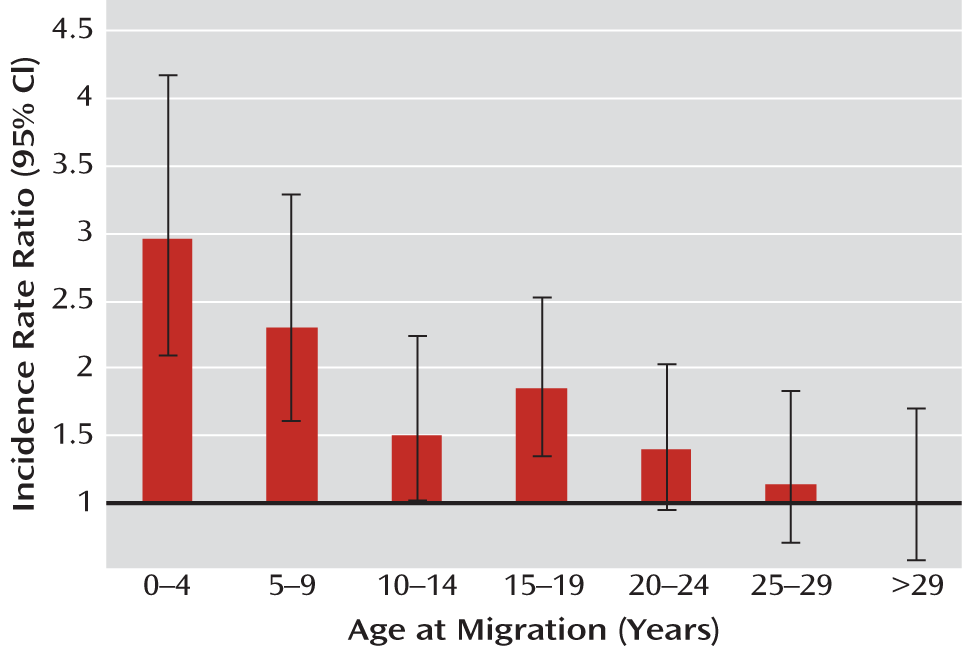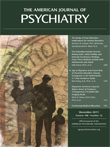Age at Migration and Future Risk of Psychotic Disorders Among Immigrants in the Netherlands: A 7-Year Incidence Study
Abstract
Objective:
Method:
Results:
Conclusions:
Method
Identification of Case Patients
Classification of Ethnicity
Population Data and Neighborhood Characteristics
Statistical Analyses
Results
| Case Patients (N=618)b | Total At-Risk Population (N=1,870,016)c | |||
|---|---|---|---|---|
| Characteristic | N | % | N | % |
| Male | 436 | 70.6 | 951,870 | 50.9 |
| Age at the time of migration (years)d | ||||
| 0–4 | 44 | 18.5 | 53,399 | 7.3 |
| 5–9 | 36 | 15.1 | 63,663 | 8.6 |
| 10–14 | 29 | 12.2 | 70,844 | 9.6 |
| 15–19 | 52 | 21.8 | 105,968 | 14.3 |
| 20–24 | 34 | 14.3 | 134,551 | 18.3 |
| 25–29 | 23 | 9.7 | 122,726 | 16.7 |
| >29 | 20 | 8.4 | 185,084 | 25.1 |
| Ethnicity | ||||
| Dutch | 226 | 36.6 | 988,869 | 52.9 |
| Surinamese | ||||
| Immigrant | 57 | 9.2 | 158,142 | 8.5 |
| Second-generation citizen | 37 | 6.0 | 34,714 | 1.9 |
| Netherlands Antillean | ||||
| Immigrant | 17 | 2.8 | 38,224 | 2.0 |
| Second-generation citizen | 4 | 0.6 | 5,500 | 0.3 |
| Turkish | ||||
| Immigrant | 37 | 6.0 | 100,712 | 5.4 |
| Second-generation citizen | 18 | 2.9 | 15,750 | 0.8 |
| Moroccan | ||||
| Immigrant | 68 | 11.0 | 73,122 | 3.9 |
| Second-generation citizen | 23 | 3.7 | 11,054 | 0.6 |
| Other non-Western | ||||
| Immigrant | 72 | 11.7 | 162,402 | 8.7 |
| Second-generation citizen | 25 | 4.0 | 68,429 | 3.7 |
| Western | ||||
| Immigrant | 22 | 3.6 | 104,740 | 5.6 |
| Second-generation citizen | 12 | 1.9 | 108,358 | 5.8 |
Analyses Restricted to Immigrant Groups
| Country of Origin | Incidence Rate Ratioa | 95% CI | χ2 (df=1) | p |
|---|---|---|---|---|
| All countries | 0.96 | 0.95–0.98 | 27.03 | 0.000 |
| All non-Western countries | 0.96 | 0.94–0.97 | 28.26 | 0.000 |
| Surinam | 0.93 | 0.89–0.97 | 12.00 | 0.001 |
| Netherlands Antilles | 0.91 | 0.86–0.97 | 8.18 | 0.004 |
| Turkey | 0.93 | 0.88–0.97 | 10.15 | 0.001 |
| Morocco | 0.96 | 0.93–1.00 | 4.97 | 0.03 |
| Other non-Western countries | 0.98 | 0.95–1.01 | 2.32 | 0.13 |
| All Western countriesb | 1.00 | 0.95–1.05 | 0.00 | 0.97 |
| Age at First Contact With a Physician (Years) | Number of Case Patients | Incidence Rate Ratioa | 95% CI |
|---|---|---|---|
| 15–19 | 30 | 0.89 | 0.83–0.96 |
| 20–24 | 73 | 0.95 | 0.92–0.98 |
| 25–29 | 69 | 0.95 | 0.92–0.97 |
| 30–34 | 38 | 0.97 | 0.93–1.00 |
| 35–39 | 39 | 0.97 | 0.94–1.01 |
| 40–44 | 10 | 1.00 | 0.94–1.06 |
| 45–49 | 9 | 1.02 | 0.96–1.08 |
| 50–54 | 5 | 1.01 | 0.92–1.10 |
Analyses of Immigrant Groups and Dutch Citizens

| All Non-Western Countries | Surinam | The Netherlands Antilles | Turkey | Morocco | Other Non-Western Countries | |||||||
|---|---|---|---|---|---|---|---|---|---|---|---|---|
| Generation | IRR | 95% CI | IRR | 95% CI | IRR | 95% CI | IRR | 95% CI | IRR | 95% CI | IRR | 95% CI |
| Immigrant | 1.95 | 1.63–2.33 | 1.77 | 1.32–2.36 | 1.69 | 1.03–2.76 | 1.38 | 0.98–1.96 | 3.43 | 2.62–4.50 | 1.82 | 1.39–2.37 |
| Age at the time of migration (years) | ||||||||||||
| 0–4 | 2.96b | 2.10–4.17 | 2.76 | 1.63–4.66 | 7.10 | 2.63–19.16 | 2.51 | 1.03–6.12 | 3.57 | 1.93–6.61 | 2.01 | 0.83–4.89 |
| 5–9 | 2.31 | 1.61–3.29 | 2.47 | 1.46–4.16 | 2.77 | 0.69–11.19 | 2.46 | 1.15–5.23 | 1.91 | 0.85–4.32 | 2.04 | 0.90–4.60 |
| 10–14 | 1.51 | 1.02–2.25 | 0.74 | 0.27–1.98 | c | c | 1.15 | 0.47–2.80 | 2.40 | 1.18–4.87 | 2.49 | 1.35–4.60 |
| 15–19 | 1.85 | 1.35–2.53 | 1.63 | 0.80–3.30 | 1.11 | 0.35–3.48 | 0.87 | 0.39–1.96 | 5.38 | 3.37–8.60 | 1.47 | 0.83–2.58 |
| 20–24 | 1.40 | 0.96–2.03 | 0.43 | 0.11–1.74 | 1.39 | 0.52–3.74 | 1.44 | 0.71–2.92 | 3.16 | 1.62–6.16 | 1.26 | 0.62–2.56 |
| 25–29 | 1.14 | 0.71–1.83 | 0.77 | 0.19–3.13 | 1.76 | 0.44–7.09 | 0.63 | 0.16–2.55 | 1.71 | 0.63–4.60 | 1.22 | 0.63–2.38 |
| >29 | 1.00 | 0.58–1.72 | 0.80 | 0.20–3.26 | c | c | c | c | 1.19 | 0.29–4.84 | 1.49 | 0.80–2.78 |
| Second-generation citizen | 1.82 | 1.43–2.32 | 2.34 | 1.63–3.34 | 1.92 | 0.71–5.17 | 2.39 | 1.47–3.89 | 4.11 | 2.65–2.38 | 0.91 | 0.60–1.38 |
Discussion
Selective Migration
Potential Confounding Factors
Ascertainment of Case Patients
Prior Research on Age at the Time of Migration
Possible Mechanisms
Implications and Future Research
Footnote
References
Information & Authors
Information
Published In
History
Authors
Funding Information
Metrics & Citations
Metrics
Citations
Export Citations
If you have the appropriate software installed, you can download article citation data to the citation manager of your choice. Simply select your manager software from the list below and click Download.
For more information or tips please see 'Downloading to a citation manager' in the Help menu.
View Options
View options
PDF/EPUB
View PDF/EPUBLogin options
Already a subscriber? Access your subscription through your login credentials or your institution for full access to this article.
Personal login Institutional Login Open Athens loginNot a subscriber?
PsychiatryOnline subscription options offer access to the DSM-5-TR® library, books, journals, CME, and patient resources. This all-in-one virtual library provides psychiatrists and mental health professionals with key resources for diagnosis, treatment, research, and professional development.
Need more help? PsychiatryOnline Customer Service may be reached by emailing [email protected] or by calling 800-368-5777 (in the U.S.) or 703-907-7322 (outside the U.S.).

